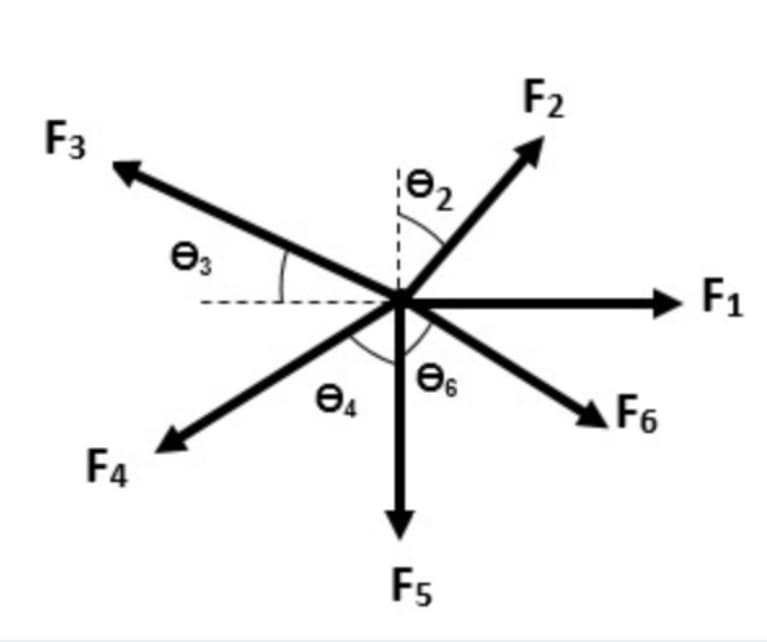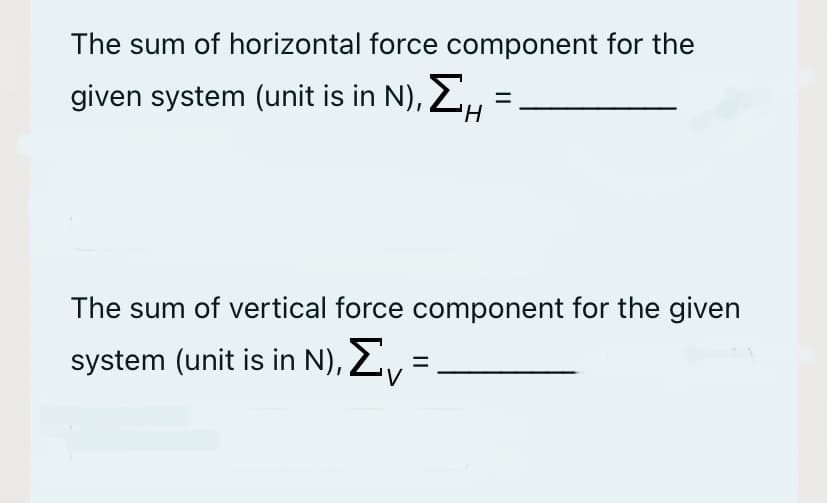Find the magnitude and direction of the resultant force for the system of forces shown in the figure. Where F1 =30 N, F2 =5N, F3 =15 N, F4 =20N, F5 = 40N & F6 =10N. The angles ϴ2 =25ᵒ, ϴ3 =30ᵒ , ϴ4 = 40ᵒ, ϴ6 = 15 ᵒ The horizontal component of Force F1 (unit is in N), H1= The vertical component of Force F1 (unit is in N), V1 = The horizontal component of Force F2 (unit is in N), H2= The vertical component of Force F2 (unit is in N), V2 = The horizontal component of Force F3 (unit is in N), H3= The vertical component of Force F3 (unit is in N), V3 = The horizontal component of Force F4 (unit is in N), H4 = The vertical component of Force F4 (unit is in N), V4 = The horizontal component of Force F5 (unit is in N), H5= The vertical component of Force F5 (unit is in N), V5 = The horizontal component of Force F6 (unit is in N), H6= The vertical component of Force F6 (unit is in N), V6 = The resultant of the given force system is (unit in N), R = The direction of Resultant Force is =
Find the magnitude and direction of the resultant force for the system of forces shown in the figure. Where F1 =30 N, F2 =5N, F3 =15 N, F4 =20N, F5 = 40N & F6 =10N. The angles ϴ2 =25ᵒ, ϴ3 =30ᵒ , ϴ4 = 40ᵒ, ϴ6 = 15 ᵒ The horizontal component of Force F1 (unit is in N), H1= The vertical component of Force F1 (unit is in N), V1 = The horizontal component of Force F2 (unit is in N), H2= The vertical component of Force F2 (unit is in N), V2 = The horizontal component of Force F3 (unit is in N), H3= The vertical component of Force F3 (unit is in N), V3 = The horizontal component of Force F4 (unit is in N), H4 = The vertical component of Force F4 (unit is in N), V4 = The horizontal component of Force F5 (unit is in N), H5= The vertical component of Force F5 (unit is in N), V5 = The horizontal component of Force F6 (unit is in N), H6= The vertical component of Force F6 (unit is in N), V6 = The resultant of the given force system is (unit in N), R = The direction of Resultant Force is =
Elements Of Electromagnetics
7th Edition
ISBN:9780190698614
Author:Sadiku, Matthew N. O.
Publisher:Sadiku, Matthew N. O.
ChapterMA: Math Assessment
Section: Chapter Questions
Problem 1.1MA
Related questions
Question
100%
Find the magnitude and direction of the resultant force for the system of forces shown in the figure. Where F1 =30 N, F2 =5N, F3 =15 N, F4 =20N, F5 = 40N & F6 =10N. The angles ϴ2 =25ᵒ, ϴ3 =30ᵒ , ϴ4 = 40ᵒ, ϴ6 = 15 ᵒ
The horizontal component of Force F1 (unit is in N), H1=
The vertical component of Force F1 (unit is in N), V1 =
The horizontal component of Force F2 (unit is in N), H2=
The vertical component of Force F2 (unit is in N), V2 =
The horizontal component of Force F3 (unit is in N), H3=
The vertical component of Force F3 (unit is in N), V3 =
The horizontal component of Force F4 (unit is in N), H4 =
The vertical component of Force F4 (unit is in N), V4 =
The horizontal component of Force F5 (unit is in N), H5=
The vertical component of Force F5 (unit is in N), V5 =
The horizontal component of Force F6 (unit is in N), H6=
The vertical component of Force F6 (unit is in N), V6 =
The resultant of the given force system is (unit in N), R =
The direction of Resultant Force is =

Transcribed Image Text:F2
F3
F1
F6
F4
F5

Transcribed Image Text:The sum of horizontal force component for the
given system (unit is in N), 2
The sum of vertical force component for the given
system (unit is in N), L:
Expert Solution
This question has been solved!
Explore an expertly crafted, step-by-step solution for a thorough understanding of key concepts.
Step by step
Solved in 3 steps with 4 images

Knowledge Booster
Learn more about
Need a deep-dive on the concept behind this application? Look no further. Learn more about this topic, mechanical-engineering and related others by exploring similar questions and additional content below.Recommended textbooks for you

Elements Of Electromagnetics
Mechanical Engineering
ISBN:
9780190698614
Author:
Sadiku, Matthew N. O.
Publisher:
Oxford University Press

Mechanics of Materials (10th Edition)
Mechanical Engineering
ISBN:
9780134319650
Author:
Russell C. Hibbeler
Publisher:
PEARSON

Thermodynamics: An Engineering Approach
Mechanical Engineering
ISBN:
9781259822674
Author:
Yunus A. Cengel Dr., Michael A. Boles
Publisher:
McGraw-Hill Education

Elements Of Electromagnetics
Mechanical Engineering
ISBN:
9780190698614
Author:
Sadiku, Matthew N. O.
Publisher:
Oxford University Press

Mechanics of Materials (10th Edition)
Mechanical Engineering
ISBN:
9780134319650
Author:
Russell C. Hibbeler
Publisher:
PEARSON

Thermodynamics: An Engineering Approach
Mechanical Engineering
ISBN:
9781259822674
Author:
Yunus A. Cengel Dr., Michael A. Boles
Publisher:
McGraw-Hill Education

Control Systems Engineering
Mechanical Engineering
ISBN:
9781118170519
Author:
Norman S. Nise
Publisher:
WILEY

Mechanics of Materials (MindTap Course List)
Mechanical Engineering
ISBN:
9781337093347
Author:
Barry J. Goodno, James M. Gere
Publisher:
Cengage Learning

Engineering Mechanics: Statics
Mechanical Engineering
ISBN:
9781118807330
Author:
James L. Meriam, L. G. Kraige, J. N. Bolton
Publisher:
WILEY